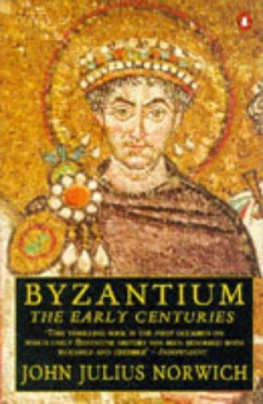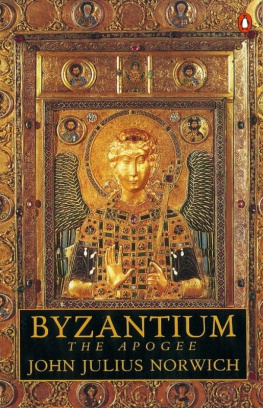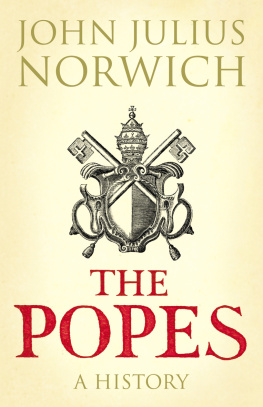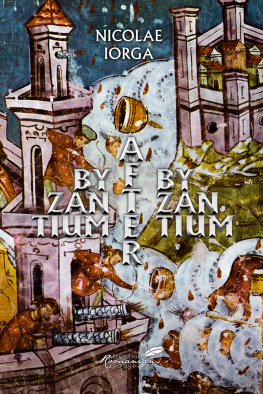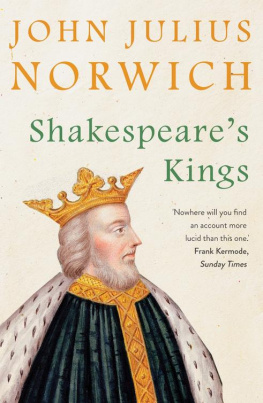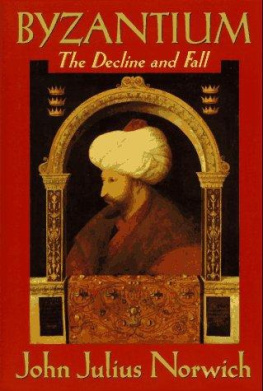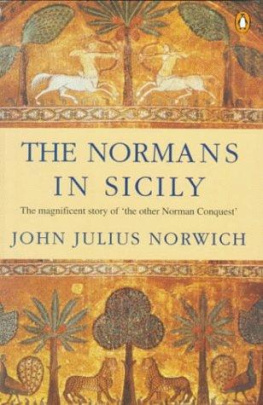JOHN JULIUS NORWICH
BYZANTIUM
The Early Centuries
PENGUIN BOOKS
PENGUIN BOOKS
Published by the Penguin Group Penguin Books Ltd, 27 Wrights Lane, London W8 5TZ, England Penguin Books USA Inc., 375 Hudson Street, New York, New York 10014, USA Penguin Books Australia Ltd, Ringwood, Victoria, Australia Penguin Books Canada Ltd, 10 Alcorn Avenue, Toronto, Ontario, Canada M4V 3B2 Penguin Books (NZ) Ltd, 182-190 Wairau Road, Auckland 10, New Zealand
Penguin Books Ltd, Registered Offices: Harmondsworth, Middlesex, England
First published by Viking 1988 Published in Penguin Books 1990 5 7 9 10 8 6
Copyright John Julius Norwich, 1988 All rights reserved
'Sailing to Byzantium' by W. B. Yeats is taken from The Collected Poems of W. B. Yeats and is reproduced by kind permission of A. P. Watt Ltd, on behalf of Michael B. Yeats and Macmillan London Ltd. The translations of Procopius by B. H. Dewing, published in the Loeb Classical Library, arc reproduced by kind permission of Wm Heinemann Ltd and Harvard University Press The translations by G. A. Williamson of Eusebius's The History of the Church, G. A. Williamson, 196S
Printed in England by Clays Ltd, St Ives pic Filmset in Garamond
Except in the United States of America, this book is sold subject to the condition that it shall not, by way of trade or otherwise, be lent, re-sold, hired out, or otherwise circulated without the publisher's prior consent in any form of binding or cover other than that in which it is published and without a similar condition including this condition being imposed on the subsequent purchaser
For Moll
Contents
Maps
Acknowledgements
Introduction
Constantine the Great [to 323]
The Adoption of the Faith [323-6]
Constantinople [326-37]
Julian the Apostate [337-63]
The Empire at Bay [363-95]
The Fall of Rome [395-410]
Of Heresies and Huns [410-53]
The Fall of the West [455-93]
The Rise of Justinian [493-532]
Belisarius [532-40]
Totila the Goth [54049]
The Last Years of Justinian [549-65]
The Downward Drift [565-610]
The First Crusader [610-641]
The Heraclian Line [641-85]
The Emperor who Lost his Nose [685-71
The First Iconoclasts [711-75]
Irene [775-802]
Byzantine Monuments Surviving in Istanbul
List of Emperors
Bibliography
Maps


Acknowledgements
My heartfelt thanks are due to Mollie Philipps, for all her hard work on the illustrations; and to Kim Erkan for her invaluable help in Istanbul.
As so often in the past, I have once again to express my gratitude and admiration to the London Library, in which virtually every word of this book has been written; and to its Librarian Douglas Matthews, for having produced yet another superb index.
Introduction
Of that Byzantine Empire the universal verdict of history is that it constitutes, without a single exception, the most thoroughly base and despicable form that civilisation has yet assumed... There has been no other enduring civilisation so absolutely destitute of all the forms and elements of greatness ... Its vices were the vices of men who had ceased to be brave without learning to be virtuous... Slaves, and willing slaves, in both their actions and their thoughts, immersed in sensuality and in the most frivolous pleasures, the people only emerged from their listlessness when some theological subtlety, or some chivalry in the chariot races, stimulated them to frantic riots... The history of the Empire is a monotonous story of the intrigues of priests, eunuchs and women, of poisonings, of conspiracies, of uniform ingratitude, of perpetual fratricides.
This somewhat startling diatribe is taken from W. E. H. Lecky's History of European Morals, published in 869; and although to modern ears it is perhaps not quite so effective as the author meant it to be - his last sentence makes Byzantine history sound not so much monotonous as distinctly entertaining - the fact remains that, for the past years and more, what used to be known as the Later Roman Empire has had an atrocious press. The long campaign of denigration seems to have been given its initial impetus in the eighteenth century by Edward Gibbon who, like all classically educated Englishmen and Englishwomen of his day, saw Byzantium as the betrayal of all that was best in ancient Greece and Rome; and it continued until well into the present century. After the First World War, under the influence of Robert Byron, David Talbot-Rice, Steven Runciman and their friends and followers, the pendulum began to swing; but it was only after the Second - when the ease, speed and relative comfort of travel in the Levant made Byzantine monuments at last generally accessible - that the Empire came into its own again and was at last recognized, in its own very different way, as a worthy successor to the two mighty civilizations which had gone before.
The trouble was, for most of us, that we knew so little about it. The old attitudes died hard. During my five years at one of England's oldest and finest public schools, Byzantium seems to have been the victim of a conspiracy of silence. I cannot honestly remember its being mentioned, far less studied; and so complete was my ignorance that I should have been hard put to define it in even general terms until I went to Oxford. Many people, I suspect, feel similarly vague today; and it is for them, above all, that this book has been written.
It does not tell the whole story. The Byzantine Empire, from its foundation by Constantine the Great on Monday n May to its conquest by the Ottoman Sultan Mehmet II on Tuesday May 1453, lasted for a total of 1,123 years and days; and, as I soon discovered when writing a history of Venice a few years ago, that sort of span simply cannot be dealt with in one volume of manageable size. One or two historians have tried it, but the results never seem to me entirely satisfactory: either the reader is presented with so sketchy and disconnected an account that he loses his way, or else he is greeted by a remorseless fusillade of facts that sends him running for cover. I have preferred a more leisurely approach, and have consequently limited this first volume to what amounts, very roughly, to the first years. The two opening chapters form a prologue, being concerned essentially with the early years of Constantine and his rise to power - a story that seems to me not just fascinating in itself, but also indispensable if we are to understand what follows; only in Chapter do we come to the inauguration of Constantinople as the New Rome, the point at which the Roman Empire - though it never cast off its old title - can properly be called the Byzantine. The volume ends years later with the coronation of Charlemagne as Roman Emperor of the West on Christmas Day, -one of the most convenient dates in all history - and the appearance, for the first time, of a rival to the old imperial throne on the Bosphorus. A sequel will carry the saga on to the Crusades; and a third volume will bring it to its heroic - and almost unbearably tragic - end.
What, you may ask, ever induced me to take on so formidable an assignment? In fact the idea originated not with me at all but with my friend Bob Gottlieb, some time before he left my American publishers to edit the New Yorker, and though I remember feeling a little daunted by the magnitude of the task he suggested, I do not think there was any real hesitation. For over a quarter of a century already I had been captivated by the Byzantine world - ever since my first visit to Greece in 1954 and, in the following year, my posting to the British Embassy,

